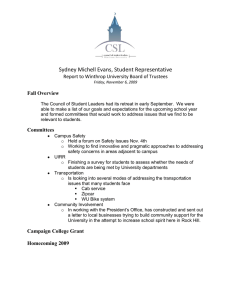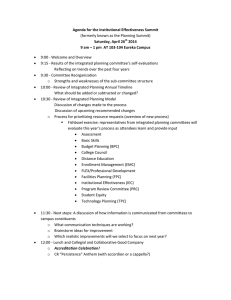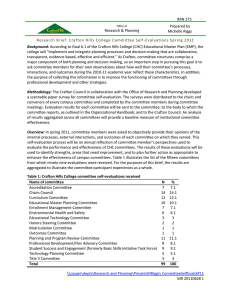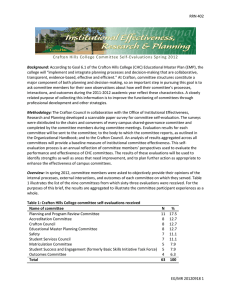Research & Planning Prepared by Michelle Riggs
advertisement
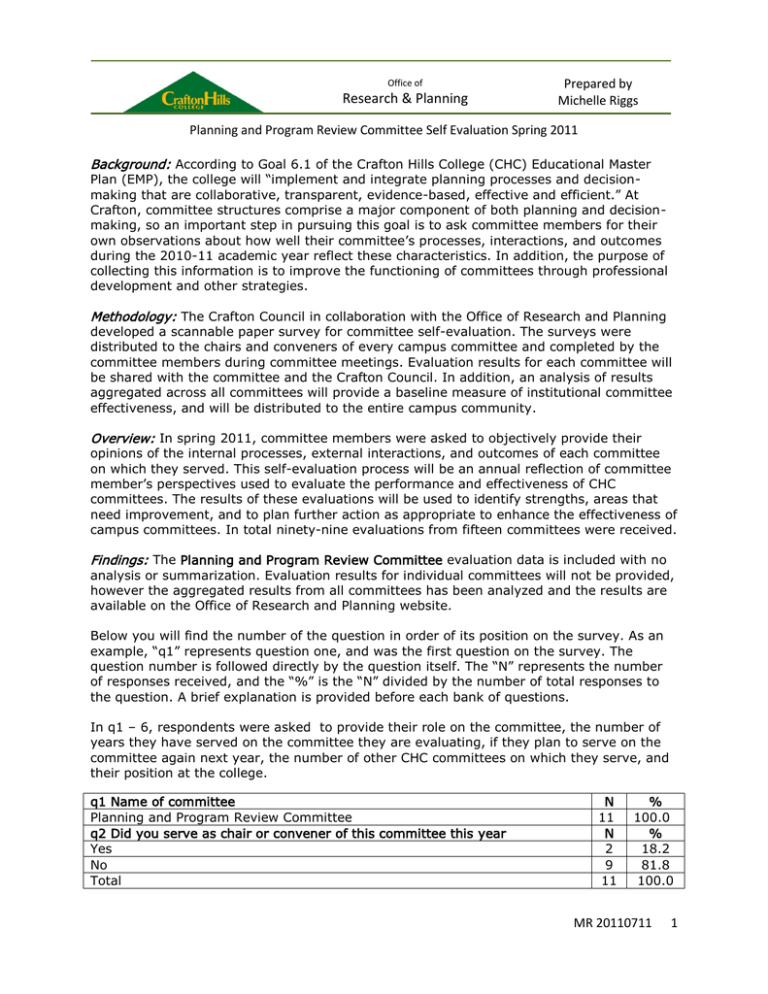
Office of Research & Planning Prepared by Michelle Riggs Planning and Program Review Committee Self Evaluation Spring 2011 Background: According to Goal 6.1 of the Crafton Hills College (CHC) Educational Master Plan (EMP), the college will “implement and integrate planning processes and decisionmaking that are collaborative, transparent, evidence-based, effective and efficient.” At Crafton, committee structures comprise a major component of both planning and decisionmaking, so an important step in pursuing this goal is to ask committee members for their own observations about how well their committee’s processes, interactions, and outcomes during the 2010-11 academic year reflect these characteristics. In addition, the purpose of collecting this information is to improve the functioning of committees through professional development and other strategies. Methodology: The Crafton Council in collaboration with the Office of Research and Planning developed a scannable paper survey for committee self-evaluation. The surveys were distributed to the chairs and conveners of every campus committee and completed by the committee members during committee meetings. Evaluation results for each committee will be shared with the committee and the Crafton Council. In addition, an analysis of results aggregated across all committees will provide a baseline measure of institutional committee effectiveness, and will be distributed to the entire campus community. Overview: In spring 2011, committee members were asked to objectively provide their opinions of the internal processes, external interactions, and outcomes of each committee on which they served. This self-evaluation process will be an annual reflection of committee member’s perspectives used to evaluate the performance and effectiveness of CHC committees. The results of these evaluations will be used to identify strengths, areas that need improvement, and to plan further action as appropriate to enhance the effectiveness of campus committees. In total ninety-nine evaluations from fifteen committees were received. Findings: The Planning and Program Review Committee evaluation data is included with no analysis or summarization. Evaluation results for individual committees will not be provided, however the aggregated results from all committees has been analyzed and the results are available on the Office of Research and Planning website. Below you will find the number of the question in order of its position on the survey. As an example, “q1” represents question one, and was the first question on the survey. The question number is followed directly by the question itself. The “N” represents the number of responses received, and the “%” is the “N” divided by the number of total responses to the question. A brief explanation is provided before each bank of questions. In q1 – 6, respondents were asked to provide their role on the committee, the number of years they have served on the committee they are evaluating, if they plan to serve on the committee again next year, the number of other CHC committees on which they serve, and their position at the college. q1 Name of committee Planning and Program Review Committee q2 Did you serve as chair or convener of this committee this year Yes No Total N 11 N 2 9 11 % 100.0 % 18.2 81.8 100.0 MR 20110711 1 q3 How long have you served continuously on this committee New member this year 2 Years N 3 4 1 3 11 N 9 1 1 11 N 1 1 2 2 5 11 N 5 1 4 1 11 3 Years 4 or More Years Total q4 Do you expect to serve on this committee again next year Yes No I don’t know Total q5 On how many other Crafton committees did you serve this year 0 2 3 4 5 or more Total q6 What is your primary function now at CHC FT Faculty Classified Manager Student Total % 27.3 36.4 9.1 27.3 100.0 % 81.8 9.1 9.1 100.0 % 9.1 9.1 18.2 18.2 45.5 100.0 % 45.5 9.1 36.4 9.1 100.0 In q7a -q7e, respondents were asked to indicate how often the committee’s processes, interactions, and outcomes during 2010-11 reflected each of the following characteristics. Choices on the Likert-scale were Almost Always, Often, Sometimes, Seldom, Almost Never, and No Opinion. q7a Collaborative: Sharing, inclusive, open to input, respectful of diverse opinions, characterized by meaningful dialogue Almost Always Total q7b Transparent: Open, easy to understand, clearly defined, characterized by effective and meaningful communication with the College community Almost Always Often Sometimes Total q7c Evidence-Based: Reliant upon relevant, accurate, complete, timely qualitative and/or quantitative information; not based solely on assertion, speculation, or anecdote Almost Always Often Total N 11 11 % 100.0 100.0 N 8 2 1 11 % 72.7 18.2 9.1 100.0 N 10 1 11 % 90.9 9.1 100.0 MR 20110711 2 q7d Effective: Working properly and productively toward the committee's intended results Almost Always Often Total q7e Efficient: Performing well with the least waste of time and effort; characterized by serving the committee's specified purposes in the best possible manner Almost Always Often Total N 10 1 11 % 90.9 9.1 100.0 N 7 4 11 % 63.6 36.4 100.0 In q8 and q9, respondents were asked to provide their opinion of the committee’s most significant accomplishment this year, and the committee’s most needed improvement in an open-ended format. q8 Please enter this committee's most significant accomplishment this year Evaluation of Program Review documents & feedback to each unit. Followed mission, vision, and institutional values of Crafton Hills while following objectives of the program Getting through all Program Review with feedback in a timely manner Launching the online version of the PPR- the online planning tool. Prioritized Objectives Program health and document feedback. Prioritizing objectives campus-wide. Really working to streamline the PPR process based on feedback & experience Reviewing all Program Reviews done this year & feedback to units The committee established a rigorous list of tasks to complete for each meeting (The PPR Timeline), kept the schedule, and completed all the tasks identified. Training and communication with PPR participants Working efficiently & providing timely feedback. Improving the process and improving dialogue with units. q9 Please enter the improvement most needed by this committee Attempt to decrease workload Continue to provide training & outreach to the campus, to improve the quality of the plans and documents Continued streamlining of process & working to sell the campus on the usefulness of the document as a tool Help new members understand the charge & objective of the committee To tie all campus planning together We are still figuring out the best way to prioritize objectives & resources We need to make the planning process less onerous In q10a -q10c, respondents were asked to indicate the extent to which they agree or disagree with statements related to their service on the committee overall. Choices on the Likert-scale were; Strongly Agree, Agree, Disagree, and Strongly Disagree. q10a I feel comfortable contributing ideas Strongly Agree Agree Total N 8 3 11 % 72.7 27.3 100.0 MR 20110711 3 q10b My ideas are treated with respect, whether or not others agree with them Strongly Agree Agree Total q10c I have had sufficient opportunities to provide input into committee recommendations Strongly Agree Agree Total N 9 2 11 % 81.8 18.2 100.0 N 10 1 11 % 90.9 9.1 100.0 In q11a -q11k, respondents were asked to rate aspects of the committee’s work overall this year using a 6-point Likert-scale with choices of Very Good, Good, Fair, Poor, Very Poor, and No Opinion. q11a Clarity of the committee's charge Very Good Good Total q11b Quality of communication within the committee Very Good Good Total q11c Quality of information flow from the committee to constituency groups Very Good Good Total q11d Quality of information flow from constituency groups to the committee Very Good Good Fair Total q11e Quality of communication by the committee with the campus community as a whole Very Good Good Total q11f Access to data needed for deliberations Very Good Total q11g Access to meeting space Very Good Good Fair Total q11h Access to other resources needed for the committee to work effectively Very Good Good Fair Total N 10 1 11 N 10 1 11 N 3 7 10 N 2 6 2 10 % 90.9 9.1 100.0 % 90.9 9.1 100.0 % 27.3 63.6 90.9 % 18.2 54.5 18.2 90.9 N 4 7 11 N 11 11 N 7 1 3 11 % 36.4 63.6 100.0 % 100.0 100.0 % 63.6 9.1 27.3 100.0 N 4 4 3 11 % 36.4 36.4 27.3 100.0 MR 20110711 4 q11i Training or mentoring for you as a committee member Very Good Good Fair No Opinion Total q11j Establishment of expectations or norms for committee members and convener(s) Very Good Good Total q11k Adherence to expectations or norms for committee members and convener(s) Very Good Good Total N 3 4 2 2 11 % 27.3 36.4 18.2 18.2 100.0 N 6 5 11 % 54.5 45.5 100.0 N 6 5 11 % 54.5 45.5 100.0 Finally, in q12 committee members were given the opportunity to leave any additional comments in an open-ended format. Additional Comments: Co-chairs were EXCELLENT. They were great leaders of the entire process. I think we have done really good work & come so far. Our time & efforts seem to be really going towards changing the process's culture & that's rewarding. The committee has a very large and pivotal task. Members have been diligent in reviewing and commenting on the unit documents and have made recommendations with great care. This has been the most successful year of the 4 years I've served as a member. Excellent leadership- again. The best I've seen, Thanks! Wireless needed in meeting rooms. MR 20110711 5
